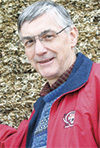A Midwestern university agronomist recommends at least one cutting each year be allowed to reach the early bloom stage – the suggestion is 10 percent bloom. The objective is to allow the alfalfa plant to reach a full level of root carbohydrates.
This recommendation was qualified by the statement that farmers not wait until bloom “if you’re comfortable with a shorter rotation for your alfalfa fields,” implying continual bud-stage harvest will eventually deplete stands – which is probably true.
Alfalfa doesn’t fully recover root carbohydrates until it approaches full bloom, so allowing the plants to reach 10 percent bloom would still come somewhat short of attaining a “full level” of root carbohydrates. Cornell University forage agronomist Jerry Cherney notes damage to alfalfa is due to a “series of small insults.”
A single insult usually isn’t fatal, but the accumulation of them eventually can take a toll. How much difference in plant health would we expect by allowing our alfalfa to reach 10 percent bloom once per season, harvesting the rest at the late bud stage, compared to taking all harvests at the late bud stage, as is recommended by many forage agronomists?
I’m sure more damage is done to alfalfa plants by wheel traffic compaction than by the small increase in root carbohydrates if harvest is delayed until early bloom. One fewer cutting per season, as may be achievable with reduced-lignin alfalfa, would almost certainly have more influence on stand life than would a slight delay in harvest.
So would the use of wider field equipment – music to the ears of farmers looking for an excuse to trade up for something “bigger and better.” It’s not that the recommendation to delay one harvest each season until 10 percent bloom is wrong, but there are other management options likely to make a bigger difference.
Reduced-lignin alfalfa provides farmers with the opportunity to delay harvest even past 10 percent bloom while still maintaining very good forage quality. The two harvest management options recommended when using reduced-lignin alfalfa are:
- Harvest at the late bud stage, resulting in “supreme-quality” alfalfa
- Harvest at about 10 percent bloom, at which point the alfalfa should have similar forage quality to that of conventional alfalfa varieties harvested at the late bud stage
If alfalfa with a “rocket fuel” forage analysis is your goal, then harvest reduced-lignin alfalfa at the bud stage – but be sure to work closely with your dairy nutrition consultant in ration balancing because this very high-protein, very low-neutral detergent fiber crop may feed more like a concentrate than a forage.
Harvesting at 10 percent bloom (slightly earlier than 10 percent is OK, too) would result in very good-quality forage plus the dual advantages of higher yield – both per cut and per season – and often at least one fewer harvest per season. Reducing the number of harvests by allowing the plants to reach 10 percent bloom would improve plant health in two ways: less plant-damaging field traffic and increased root carbohydrate levels.
The Midwestern agronomist suggested allowing second or third cut to reach early bloom. Third cut perhaps but, with conventional alfalfa varieties, second cut should be mowed no later than the full bud stage. Second-cut alfalfa stems (and sometimes third-cut stems depending on when the crop is harvested) lignify very quickly, and every effort should be made to get this crop harvested at the bud stage, even if it means harvesting at somewhat less than a 30-day interval.
It’s even more important to be aggressive in managing summer harvests of alfalfa seeded with a forage grass – especially a species such as tall fescue that can produce a fair amount of regrowth. It’s already a challenge to manage grasses in an alfalfa-grass stand, even with intensive harvest management. Delaying harvest past the late-bud stage would just make the situation worse.
As you might have surmised, second-cut alfalfa is far from my favorite forage. I believe, at least in the northeastern U.S., second-cut alfalfa gained its good reputation over 50 years ago when farmers were making a lot more dry baled hay and much less hay crop silage.
Compared to first cut, when second-cut alfalfa was mowed, there were more hours of sunlight, the soil surface usually was drier, and second-cut alfalfa yields are about half that of first cut. Therefore, it was much easier to dry second-cut alfalfa – lower yield and better drying conditions. And a bale of second-cut alfalfa with those fine stems certainly makes a pretty package.
Appearances, however, are deceiving. Second-cut alfalfa stems are fine-textured, but they’re also wiry and highly lignified. Field tests at the William H. Miner Agricultural Research Institute in Chazy, New York, found the stem quality of bud-stage second-cut alfalfa was no better than that of full-bloom first cut.
When managing conventional alfalfa varieties (and especially alfalfa seeded with a cool-season forage grass), I think farmers should time harvests so they never see an alfalfa blossom from seeding until they rotate to another crop. What sometimes happens is: Wet weather, equipment breakdowns and other delays result in your alfalfa coming into bloom at least once during the growing season anyway, but that’s different than intentionally letting the crop bloom. ![]()

-
Everett D. Thomas
- Oak Point Agronomics Ltd.
- Email Everett D. Thomas









